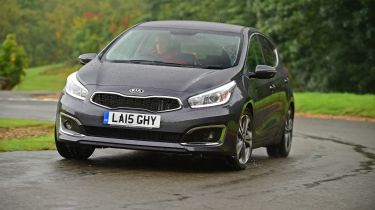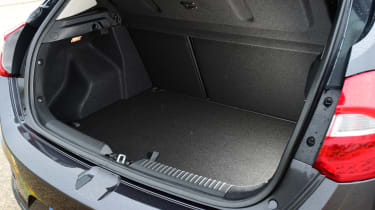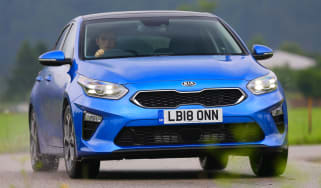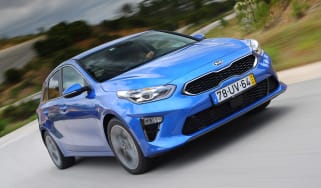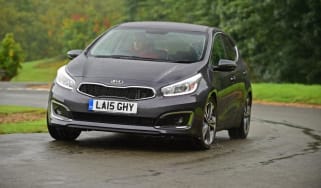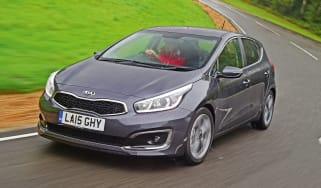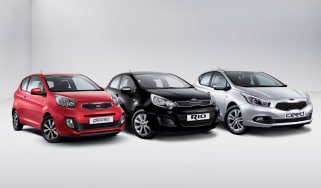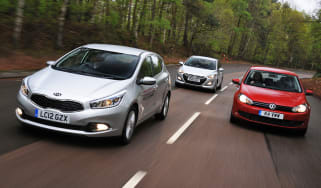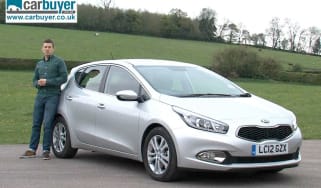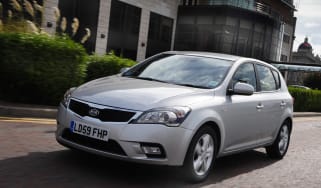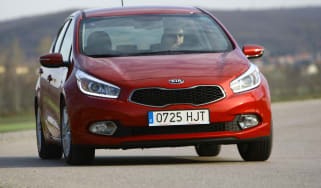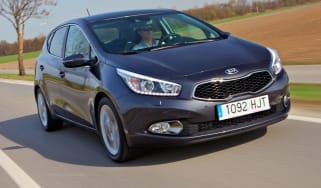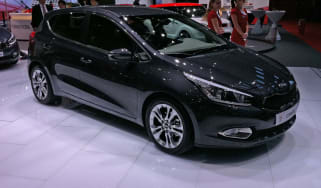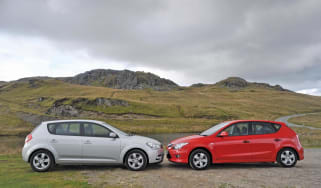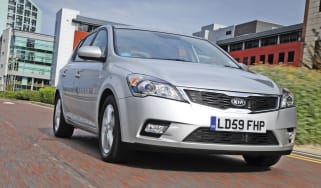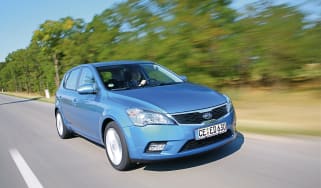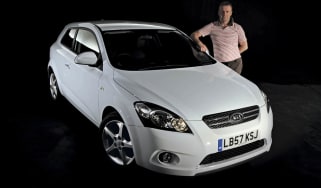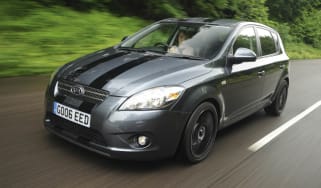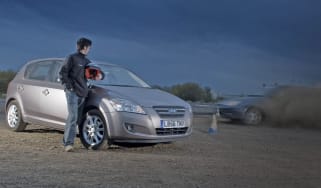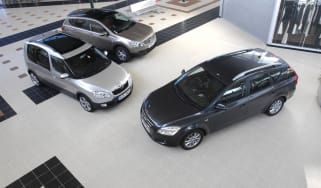Kia Cee'd (2012-2018) review
The Kia Cee’d offers practicality and solid build quality, but the driving experience is on the dull side
Kia’s new 1.0 three-cylinder turbo engine adds efficiency and cuts emissions in the facelifted Cee’d. It’s been a long time coming, but the downsized unit is worth the wait, delivering adequate performance and lower running costs.
On top of this there’s also a new seven-speed dual-clutch gearbox available in conjunction with the higher-powered 1.6-litre turbodiesel engine.
Kia’s also improved the quality and styling inside and out with a few minimal changes and a new sporty-looking trim level – as well as updates to the GT warm hatch – putting the Cee’d back in the running in the family hatch sector.
It may have a rather unconventional name, but the Slovak-built Kia Cee’d is a straightforward and conventional competitor for established European family hatchbacks such as the Ford Focus, Volkswagen Golf and the Vauxhall Astra.
There are plenty of other options for less badge conscious buyers, of course, including the Hyundai i30, Fiat Tipo, Nissan Pulsar, Skoda Octavia or even the SEAT Leon. That’s a pretty challenging bunch the Cee’d must see off. It was the first Kia to benefit from the famed seven-year warranty, which gives it a unique selling point in the segment.
Used - available now
The first Kia Cee'd arrived in 2006 and represented a watershed moment for the brand. It was the first Kia to be designed and built in Europe, and the prices started from a headline-grabbing £11,000.
It was hardly exciting, but compared with previous models, such as the Cerato, Mentor and Shuma, it represented a quantum leap forward for the Korean giant. We're dozing off just thinking about those old models. Zzzz...
An estate version arrived soon after, wearing an SW tag to inject a little glamour into an otherwise dull but worthy wagon, along with a three-door version, with a Pro_Cee'd badge, to ensure the daft name box wasn't left unchecked.
The Cee'd was facelifted in 2010, before an all-new version was unveiled 2012. By now, the Cee'd had cemented itself as a key player in the family hatchback sector, but it remained a little short of the segment best.
Step forward a new, sharper design, led by European design chief, Gregory Guillaume, and overseen by chief design officer, Peter Schreyer. This time, the Cee'd was about more than just a seven-year warranty.
The current Cee'd – which was given a subtle facelift in 2016 – is slightly prettier than before, better to drive, and blessed with a nicer interior. But the trade-off is an increase in price, with the Cee'd no longer occupying the bargain basement end of the market.
Prices start from just over £15,000 for the admittedly well-equipped Cee'd 1, but you'll pay upwards of £20,000 for the top-spec GT-Line models. You can buy a basic Fiat Tipo for £13,795, possibly less, after a little haggling. In fairness, the Cee’d is cheaper than the entry-level Hyundai i30 and Peugeot 308, and you do get a seven-year warranty.
While the five-door hatchback remains the most popular version of the Cee'd, it's also available in three-door Pro_Cee'd guise and Sportswagon estate.
While the Cee’d name may be unusual, Kia’s trim level nomenclature is more straightforward. The entry level model is the Cee’d 1, while the better equipped models are badged 2, 3 and 4. The GT-Line and GT-Line S models are designed to provide the styling of the Cee’d GT, with no changes to the steering, suspension or brakes.
Spec levels for the Cee’d 1 aren’t bad, with DAB radio and air-con included, as well as Bluetooth, LED running lights and front electric windows. The Cee’d 2 adds 16-inch alloys, 7-inch touchscreen navigation and a reversing camera, as well as electric folding mirrors, cruise control and cornering lights. The Cee’d 3 brings 17-inch alloys, dual zone air-con and parking assist, while the Cee’d 4 adds leather heated seats, a stop/start button, panoramic sunroof and an electronic parking brake.
There’s also a sporty-looking Cee’d GT-Line with side-sill extensions and distinctive front LED ‘Ice Cube’ lights, while the GT-Line S adds Xenon adaptive lighting and Lane Departure warning to the kitbag.
All the Cee’d engines are EU6 compliant for emissions, including the 99bhp 1.4-litre petrol entry-level unit. You can also choose a 133bhp 1.6 petrol, but we rather like the ‘downsized’ 1.0-litre three-cylinder ecoTurbo petrol unit with 118bhp.
Diesel enthusiasts have a decent choice too, with an 89bhp 1.4-litre CRDi and two 1.6-litre turbodiesel options making 108bhp or 134bhp. The latter is offered with Kia’s new seven-speed DCT gearbox.
Engines, performance and drive
The highlight here is Kia’s new three-cylinder 1.0-litre turbo petrol, which was lacking from the old line-up. Coming in 99bhp and 118bhp versions, it offers smooth torque with strong refinement. The higher-powered version is quicker, taking 11.1 seconds to accelerate from 0-62mph, which feels adequate on the road.
The six-speed manual is light and easy to use, aiding the impressive refinement and zippy performance on the road given the small engine and the size of the Cee’d.
There is still a pair of naturally aspirated petrols, but their emissions and performance can’t match the 1.0-litre ecoTurbo, even if the three-cylinder engine will be more expensive when full range pricing is confirmed.
When it comes to the diesels, it’s the 1.6 CRDI that’s the one to go for. The 1.4 is acceptable, but the refinement from the larger capacity oil burner is better – plus there’s more performance on offer.
Like the 1.0 turbo, it comes with two power outputs, and if you go for the more potent 134bhp version there’s lots of smooth torque that delivers acceleration on a par with its rivals. The 0-62mph sprint takes 10.2 seconds if you go for the six-speed manual and 10.6 if you opt for the new seven-speed dual-clutch transmission.
Unlike some DCT gearboxes fitted to performance cars, however, this transmission focuses on smoothness and refinement, shuffling cogs with little fuss but a noticeable delay. The steering wheel shift paddles aren’t really necessary, and we’d advise leaving the gearbox in auto mode for most of the time.
Here it helps when you want a burst of acceleration, as despite the delay the seven-speed unit kicks down smoothly. The engine revs sweetly and is relatively quiet for a diesel, as Kia has worked harder on improving refinement in this facelifted car with even more sound deadening.
However, one area where the Cee’d isn’t any better is the steering. The wheel is devoid of any feedback, and although it’s light making the car easy to manoeuvre in tight spaces, on more open roads it feels lifeless and gives the car a lethargic feel.
The ride is improved over its predecessor, with a little more compliance over bumps and a more settled gait at high speeds. However, there’s still a firm edge to the suspension’s damping, which is highlighted on bumpier country roads.
Engines
Kia offers a fashionable 1.0-litre 3-cylinder engine with two power outputs in the Cee'd, and CO2 emissions are now down to 115g/km in the higher-power variant of this engine. It’s refined, relatively torquey and a good first effort from Kia at a turbocharged triple.
However, if you’re thinking of test driving this engine, make sure you sample both power outputs to see if the 99bhp version is adequate for you. Despite the same 171Nm of torque, it is 1.7 seconds slower from 0-62mph than the 118bhp version.
Elsewhere, a range of petrol and diesel options are available. The highest-powered 1.6-litre diesel is the only engine to come with Kia's dual-clutch DCT transmission, though - the other engines get an old-fashioned torque converter, which saps power and increases fuel consumption.
MPG, CO2 and Running Costs
Kia’s new turbo engine has opened the Cee’d range up to a group of new buyers who were after the practical, affordable and well-equipped car with a low CO2 petrol. Emissions are now down to 109g/km for the low power model and 115g/km for the more powerful version. This works out at 60.1 and 57.6mpg respectively.
As a result road tax is affordable at £140 and £160 each for the year, helped by Kia’s ISG intelligent stop and go system.
The most economical diesel version is the actually the 1.6, which returns 78.5mpg according to Kia’s figures with a best of 94g/km CO2, equating to first-year road tax of £120.
Other engines in the range offer competitive efficiency, even though they aren’t class leading. However, the Cee’d GT’s 1.6-litre turbocharged petrol engine is still the one of the dirtiest in its class, returning a quoted 38.2mpg and 170g/km CO2.
Insurance groups
Insurance groups for the new Cee’d range from group seven for the entry-level 1.4 petrol in ‘1’ trim, while the high performance GT model comes in at group 26. These ratings are about average for the class.
Spec the Cee’d up with more tech and equipment and insurance costs will rise in line with rivals, so it shouldn’t cost that much more to cover than any of its major competitors.
Depreciation
Our experts haven’t yet predicted residual values for the new Cee’d, but with more tech and increased efficiency, we’d expect the residual values of the new car to be stronger than its predecessor.
The old entry-level 1.4 ‘1’ petrol will hold onto a relatively strong 42.1 per cent of its value. However, it was the old VR7 estate model that commands the strongest RVs, retaining 47.1 per cent, so expect a similar performance from the new car.
Residual values of the pre-facelift 1.6 diesel Cee’d hovered around 36 to 44 per cent – extra equipment as standard should haul second hand prices up across the range, while the attractive 1.0 turbo will help used values, too.
To get an accurate valuation on a specific model check out our free car valuation tool...
Interior, design and technology
The biggest update to the interior of the Cee’d is the new connected services system powered by TomTom. This includes live traffic updates for the sat-nav, as well as speed camera alerts, local search functionality and weather data. It’s all controlled by the same touchscreen as before, which is responsive and intuitive to use.
Apart from a few more chrome effect pieces of trim, the interior is identical to the old Cee’d, which is no bad thing. The swooping dash design still looks fresh and the ergonomics are good, with a decent amount of space and storage in the front.
However, while material quality is good on the whole, there are a few areas of cheap, hard plastic that jar with the soft-touch high-quality materials on the dashboard. It unfortunately lets the quality image down when compared with rivals like the Volkswagen Golf.
With a new Brown Pack adding an extra element of customisation to the interior alongside the other colour packs on offer, there’s a little more scope for personalising the Cee’d, especially if you go for the GT Line trim. Apart from this, the standard range of paint colours suits the car.
On the whole, it’s a definite improvement on the outgoing car, with more tech and a few more options to add extra style inside and out. However, lower quality materials in prominent places inside mean you can easily see where Kia has saved some cash.
By adding the GT Line specification to the Cee’d range, buyers can now go for the sporty looks of the Cee’d GT without that car’s firmer suspension and more focused setup.
It adds a deeper front and rear bumper, with the GT’s ‘ice-cube’ LED running lights, side skirts and larger alloy wheels.
The regular Cee’d is a sharp looking car, so these sportier modifications mean there’s even more style on offer, as the Kia integrates its rear doors more subtly than some other vehicles like the Ford Focus and Vauxhall Astra.
Sat-nav, stereo and infotainment
As above, the new infotainment system boasts some clever connected services that’ll be available to Cee’d owners for seven years as part of the purchase price, but apart from that, there’s not much new. Which is no great shame, as the large, bright, 7.0-inch touchscreen is easy to use, controlling the audio and navigation systems. It’s fairly easy to pair your mobile to, while USB connectivity means you can charge it on the move, too.
Practicality, comfort and boot space
Three body styles are available, meaning you can tailor what shape and size Cee’d you want depending on the level of practicality you need.
There’s plenty of space to stow items such as mobile phones inside the cabin, as the Cee’d boasts a roomy glovebox and door bins. There are two cupholders behind the gear lever and a large storage area in front.
Despite the rakish styling for a family hatch, visibility is good – but even if you find it difficult to manoeuvre, there’s a reversing camera available to help when parking and turning round.
The driving position is good, with lots of adjustment in the seats and steering wheel so you can get just right behind the wheel.
Dimensions and size
At 4.3 metres long, 1.8 metres wide and 1.5 metres tall, the Cee’d is smack bang in the middle of the family hatch class. For reference, Volkswagen's Golf is 4.3 metres long, 1.8 metres wide and 1.5 metres tall…
This means it’s simple to park and drive, helped by the strong visibility.
Leg room, head room & passenger space
The three-door is obviously sportier, but the five-door Cee’d strikes a nice balance between ease of use and looks. Access to the rear is good thanks to a fairly large opening, and once you’re back there, there’s an adequate amount of legroom. The relatively high roofline means even taller adults won’t be rubbing their heads on the roof in the back.
Boot space
At 380 litres boot space is unchanged and is on a par with rivals such as the Volkswagen Golf and SEAT Leon. A wide hatch and a good opening means it’s easy to load, too. Fold the rear seats down and there’s a maximum of 1,318 litres on offer in the five-door model, while the Sportswagon estate offers 528 litres and 1,642 litres respectively.
Reliability and Safety
The Kia Cee’d performed brilliantly in our 2017 Driver Power Survey, winning the Best Compact Family Car award and finishing fifth overall out of 75 new cars. The Cee’d scored 93%, with owners praising its fuel economy, running costs and exterior styling.
Further reassurance comes in the form of Kia finishing third overall on the list of best manufacturers, while the Cee’d scooped top place in the ‘Infotainment, Connectivity and Electrics’ category.
As part of the tech updates for the new Cee’d, Kia has also added a traffic sign recognition camera, which will display the speed limit of the road to the driver in the car’s instrument panel. There’s also blind spot warning and rear cross traffic alert which will warn you of an approaching car if you’re backing out of a parking space.
There’s a Smart Parking Assist System that means the Cee’d will manoeuvre itself into a space or bay, while it’ll also steer itself out of kerbside spaces to reduce the likelihood of parking dings and dents.
Underneath the skin of the Cee’d the car’s structure hasn’t changed, which means it retains the full five-star Euro NCAP crash safety rating.
Warranty
This is where the Cee’d comes into its own. All Kias come with a seven-year warranty, which highlights just how much confidence the Korean manufacturer has in its products.
The warranty package covers you up to 100,000 miles, but for the first three years it’s an unlimited deal. There’s also one year’s roadside assistance cover with all new cars. Combined, this makes Kia’s warranty package the best in the industry.
Servicing
Kia offers two different servicing packages on the Cee’d – Care-3 and Care-3 Plus. These last for three or five years depending on customer choice and cost £329 and £609 respectively for the shorter period. It’s slightly more than packages offered by rivals like Skoda, but the costs are still acceptable.

